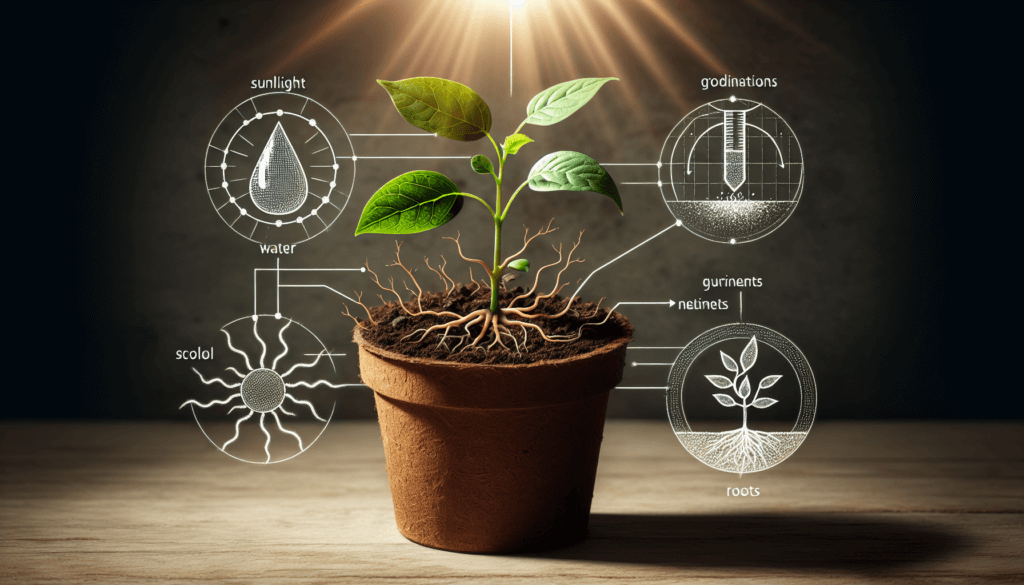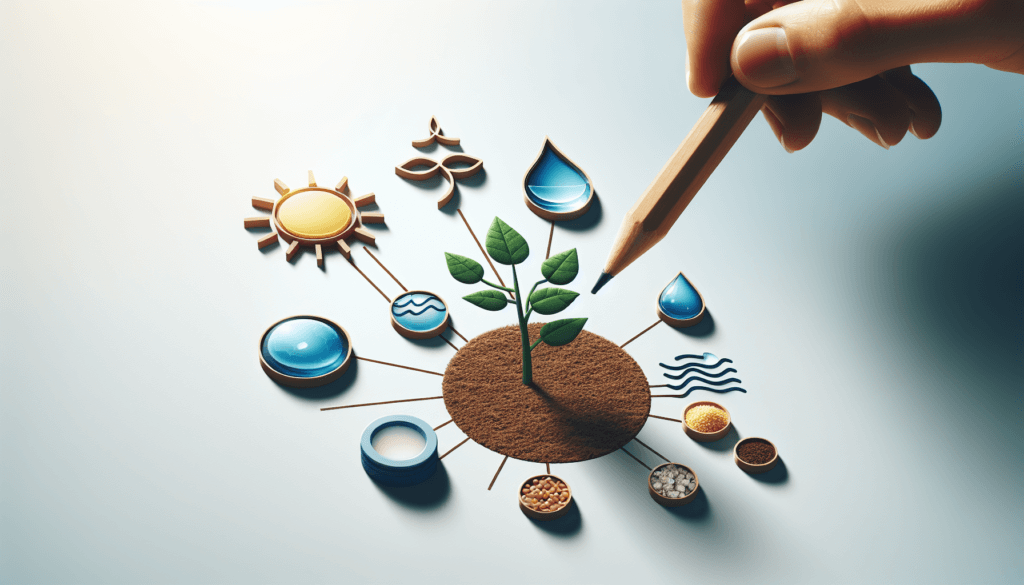Have you ever wondered what it takes for plants to thrive and grow? Well, look no further, because this article will shed light on the basic requirements that every plant needs to flourish. From sunlight to water, nutrients to proper air circulation, understanding these essentials will not only help you become a more knowledgeable plant parent but will also ensure your green friends are provided with the best conditions for their growth. So, let’s dig in and discover what plants truly need to thrive!
Water
Importance of water
Water is essential for the growth and survival of plants. It plays a vital role in various plant processes, including photosynthesis, nutrient uptake, and transportation of minerals. Water helps to maintain turgidity and cell structure, allowing plants to stay upright and maintain their shape. Additionally, water acts as a medium for the distribution and absorption of essential nutrients within the plant. Without sufficient water, plants can wilt, become stunted, and eventually die.
Frequency of watering
The frequency of watering plants depends on various factors such as the type of plant, environmental conditions, and the type of soil. It is important to provide plants with regular and adequate water, but not to overwater them. The best approach is to water the plants when the topsoil feels dry to touch. This helps to prevent waterlogging and ensures that the plant’s roots receive enough oxygen. It is also important to note that plants may require more water during hot and dry periods, whereas less frequent watering is needed during cooler seasons.
Water quality
The quality of water used for watering plants is crucial for their overall health. Ideally, plants prefer water that is free from contaminants, chemicals, and excessive minerals. If possible, it is recommended to use rainwater or filtered water. Tap water, especially if it contains high levels of chlorine or fluoride, may negatively impact plant health. However, if tap water is the only option, you can improve its quality by allowing it to sit in an open container for a day or by using a water filter.
Light
Types of light
Plants require light for the process of photosynthesis, which is essential for their growth and development. There are two primary types of light that plants need: natural sunlight and artificial light. Natural sunlight provides a full spectrum of light and is often the best source for plants. However, if natural light is insufficient or not readily available, artificial light sources such as fluorescent or LED grow lights can be used. These lights mimic the wavelengths of sunlight that are crucial for photosynthesis.
Duration of light exposure
The duration of light exposure is essential for the growth of plants. Most plants require a minimum of 6 to 8 hours of light per day to carry out photosynthesis effectively. However, some plants, such as tropical plants or those grown indoors, may require longer light exposure ranging from 10 to 14 hours per day. It is important to provide consistent and regular light exposure to plants, maintaining a balance between light and darkness.
Light intensity
Light intensity refers to the brightness or amount of light available to plants. Different plants have varying light intensity requirements. Low-light plants, such as ferns or snake plants, thrive in areas with lower light levels, while high-light plants, like succulents or cacti, require intense light exposure. It is crucial to place plants in the appropriate light conditions to ensure their healthy growth. Too much or too little light intensity can lead to stunted growth, poor flowering, and even plant death.

Temperature
Optimal temperature range
Temperature is a vital factor influencing plant growth and development. Each plant species has an optimal temperature range in which they thrive. Most common plants prefer temperatures between 65°F to 75°F (18°C to 24°C) during the day and slightly cooler temperatures at night. However, it is important to research the specific temperature preferences of the plants you are growing to ensure their optimal growth. Tropical plants may require higher temperatures, while certain cold-tolerant plants can withstand lower temperatures.
Effects of extreme temperatures
Extreme temperatures, whether too hot or too cold, can have detrimental effects on plants. High temperatures can lead to wilting, scorching of leaves, and even plant death. On the other hand, extremely cold temperatures can cause frost damage, freezing of plant tissues, and hinder nutrient absorption. It is important to protect plants from extreme temperatures by providing shade during hot summer days, using protective coverings during frost or freeze events, or moving potted plants indoors during severe weather conditions.
Soil
Composition of soil
The composition of soil plays a crucial role in providing a suitable environment for plant growth. Healthy soil is a combination of organic matter, minerals, air, and water. The soil should have good texture, allowing for adequate drainage while retaining enough moisture. It should also contain essential nutrients and micronutrients that plants need for their growth. Soil pH is another important aspect as it affects nutrient availability. Most plants prefer slightly acidic to neutral soil, with a pH range between 6.0 and 7.0.
Drainage
Proper drainage is important to prevent waterlogging, which can lead to root rot and other plant diseases. It is crucial to ensure that the soil has good drainage by incorporating organic matter, such as compost, into the soil. This helps to improve the soil structure and allows excess water to drain away. For potted plants, it is equally important to have drainage holes in the bottom of the pot to ensure water can flow freely.
Nutrient availability
The availability of nutrients in the soil is essential for plant growth. Nutrients can be broadly categorized into macronutrients and micronutrients. Macronutrients, such as nitrogen, phosphorus, and potassium, are required in larger quantities, while micronutrients, such as iron, manganese, and zinc, are needed in smaller amounts. It is important to ensure that the soil has an adequate supply of these nutrients for plants to thrive. Regularly testing the soil and amending it with organic fertilizers or specific nutrient supplements can help maintain optimal nutrient availability.

Nutrients
Macronutrients
Macronutrients are vital for plant growth and are required in larger quantities compared to micronutrients. The primary macronutrients include nitrogen (N), phosphorus (P), and potassium (K), often referred to as NPK. Nitrogen promotes leafy growth, phosphorus supports root development and flowering, while potassium aids in overall plant health and disease resistance. It is important to provide plants with a balanced supply of macronutrients through organic fertilizers or synthetic fertilizers.
Micronutrients
Micronutrients are essential for plant growth, although required in smaller amounts compared to macronutrients. These include minerals such as iron (Fe), manganese (Mn), zinc (Zn), and others. Micronutrients are responsible for various plant functions, including enzyme activation and chlorophyll production. A deficiency or imbalance of micronutrients can significantly affect plant health and growth. The addition of micronutrient-rich supplements, such as compost or specific fertilizers, can help ensure an adequate supply.
Fertilizers
Fertilizers are used to supplement the soil’s nutrient content and provide plants with essential elements for growth. They come in various forms, including organic and synthetic options. Organic fertilizers, such as compost or manure, are derived from natural sources and improve soil structure while slowly releasing nutrients. Synthetic fertilizers, on the other hand, provide readily available nutrients but should be used carefully to avoid overuse, which can lead to nutrient imbalances or environmental pollution.
Air
Gas exchange
Plants require a continuous exchange of gases, particularly carbon dioxide (CO2) and oxygen (O2), for photosynthesis and respiration. During the day, plants absorb CO2 and release O2 through tiny openings called stomata in their leaves. At night, the process is reversed, with plants absorbing O2 and releasing CO2. Ensuring proper air circulation around plants helps maintain a healthy balance of gases, allowing them to carry out vital physiological processes effectively.
Carbon dioxide levels
Carbon dioxide is an essential component for photosynthesis, and an adequate supply is crucial for plant growth. In indoor environments or enclosed spaces, such as greenhouses, plants may benefit from increased carbon dioxide levels to enhance their photosynthetic efficiency. However, in open outdoor settings, plants generally have sufficient access to atmospheric CO2. Monitoring and adjusting carbon dioxide levels, particularly in controlled environments, can contribute to optimal plant growth.
Humidity
Humidity plays a crucial role in maintaining proper plant health. Different plants have varying humidity preferences, with some preferring higher levels and others thriving in drier conditions. In general, most houseplants prefer humidity levels between 40% and 60%. Low humidity can lead to dry and withered plants, while excessive humidity can promote fungal growth and diseases. Monitoring and adjusting humidity levels, particularly in indoor environments, can help create a suitable atmosphere for plant growth.

pH Level
Acidic or alkaline soil
The pH level of the soil refers to its acidity or alkalinity. Most plants prefer slightly acidic to neutral soil, with a pH range between 6.0 and 7.0. However, some plants have specific pH preferences, and it is important to research their requirements. Acid-loving plants, such as azaleas or blueberries, thrive in more acidic soil, while alkaline-loving plants, such as lavender or clematis, prefer alkaline conditions. Understanding the pH requirements of your plants and adjusting the soil pH accordingly can promote healthy growth.
Effects on nutrient availability
Soil pH directly affects the availability of nutrients to plants. Nutrients tend to become more or less available to plants depending on the soil’s pH. For example, at higher pH levels, certain nutrients like iron and zinc become less available to plants, leading to deficiencies. Conversely, at lower pH levels, nutrient availability can be negatively affected. Regular soil testing and adjusting the pH, if necessary, through the addition of organic matter or soil amendments can help optimize nutrient availability for plants.
Space and Air Circulation
Adequate spacing
Proper spacing between plants is essential for their healthy growth. Overcrowding can lead to competition for resources, lack of airflow, and increased risk of diseases. When planting, ensure that there is enough space for the mature size of each plant, accounting for their growth habits. Sufficient spacing allows plants to receive adequate light, water, and nutrients, and promotes good air circulation, reducing the risk of pests and diseases.
Importance of air circulation
Good air circulation around plants is vital for their overall health. It helps prevent the buildup of stagnant air, which can contribute to the development and spread of diseases caused by fungi, bacteria, or pests. Adequate airflow facilitates gas exchange, maintains proper humidity levels, and deters the growth of harmful pathogens. Placing plants in areas with natural air movement, using fans, or periodically opening doors and windows can help improve air circulation.
Preventing disease
Proper spacing and air circulation are crucial in preventing plant diseases. When plants are overcrowded and lack airflow, moisture levels can increase, creating a favorable environment for fungal and bacterial diseases. By providing enough space and ensuring good air circulation, you can reduce the risk of diseases and keep your plants healthy. Additionally, practicing good sanitation, removing diseased plant material promptly, and avoiding overwatering can also help prevent the spread of diseases.

Pruning and Maintenance
Trimming and shaping
Regular pruning and shaping of plants are important for maintaining their form and promoting healthy growth. Trimming dead, damaged, or overgrown branches helps improve the plant’s appearance, allows for better light penetration, and prevents the spread of diseases. Shaping plants through selective pruning encourages bushier growth and enhances their overall aesthetic appeal. It is important to use clean, sharp tools and follow proper pruning techniques to minimize stress on the plant and ensure optimal results.
Removal of dead or damaged parts
Removing dead or damaged parts of plants is essential for their vitality and overall health. Dead or decaying leaves, stems, or flowers can serve as breeding grounds for pests and diseases. By promptly removing these, you can prevent the spread of infections and allow the plant to allocate its resources to healthy growth. Regular inspection and maintenance, along with proper care and attention, contribute to the longevity and vibrancy of your plants.
Pests and Disease Control
Identifying and treating pests
Pests can be a common threat to plant health and can cause significant damage if not properly managed. It is important to regularly inspect plants for signs of pests, such as chewed leaves, discoloration, or visible insects. Identifying the specific pest is crucial in determining the most effective treatment method. Depending on the severity of the infestation, organic or chemical pest control options can be used. Implementing preventive measures, such as maintaining good hygiene and using natural pest repellents, can also help minimize pest issues.
Preventing and managing diseases
Plant diseases are often caused by pathogens, such as fungi, bacteria, or viruses, and can severely affect plant growth and vitality. Good cultural practices, including proper watering, adequate spacing, and good air circulation, play a significant role in disease prevention. Additionally, practicing crop rotation, regular inspection for signs of diseases, and prompt removal of infected plant material can help manage and prevent the spread of diseases. In some cases, using disease-resistant plant varieties or applying organic fungicides may be necessary.



